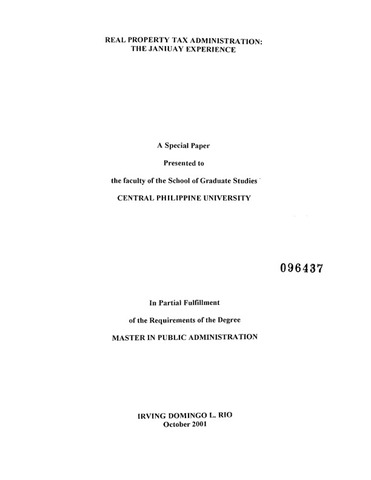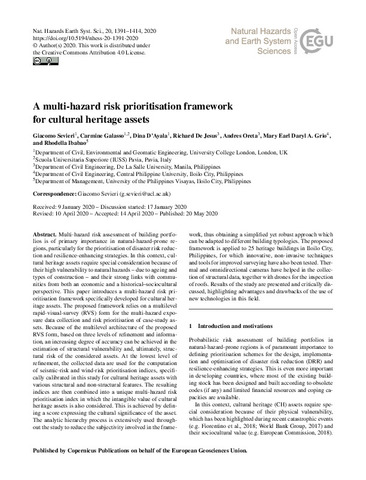Real property tax administration: The Janiuay experience
| dc.contributor.adviser | Zapanta, Lea S. | |
| dc.contributor.author | Rio, Irving Domingo | |
| dc.coverage.spatial | Janiuay | en_US |
| dc.date.accessioned | 2022-02-17T02:00:00Z | |
| dc.date.available | 2022-02-17T02:00:00Z | |
| dc.date.issued | 2001 | |
| dc.identifier.citation | Rio, I. D. L. (2001). Real property tax administration: The Janiuay experience (Unpublished Master’s thesis). Central Philippine University, Jaro, Iloilo City. | en_US |
| dc.identifier.uri | https://hdl.handle.net/20.500.12852/1946 | |
| dc.description | Abstract only | en_US |
| dc.description.abstract | This study is descriptive in nature. It aims to describe the perception of real property owners towards the computerization of real Property Tax Administration (RPTA) in its three major phases, namely: assessment, collection and record maintenance. The respondents’ perceptions were then categorized as to age, income level, educational attainment, and sex. The focus of the study is Barangay Jibolo, Janiuay, Iloilo. There are 757 registered real property owners in the said area and out of this number, 64 respondents were selected as the sample population through statistical computation. Being a descriptive study, the frequency and percentage distributions were deemed as the most appropriate statistical tool to be used based on the objectives of the study. Major findings of the study showed that real property owners in Barangay Jibolo have a high positive perception towards the computerization of real property tax administration. In all major phases, the cumulative percentage of category “very satisfactory” and “satisfactory” was consistently above 85 percent. This indicated that the services offered by the local government was perceived by the people as pro-active and client oriented. Despite this level of respondents perception, there is still more room for improvement as shown by the data gathered, wherein majority of the subjects perceived proper transaction time with the local government should be 30 minutes and below. The study further recommend that tax collection and property assessment processes be located in one office and that real property tax notice be sent directly to the taxpayers in order to rid them of unnecessary processes when paying their taxes. Furthermore, the study recommends that local officials be tapped in the tax collection effort of the government and that adequate financial incentives be provided to them. | en_US |
| dc.format.extent | 45 leaves | en_US |
| dc.language.iso | en | en_US |
| dc.subject.ddc | GSL Theses 351.072 R476 | en_US |
| dc.subject.lcsh | Tax collection | en_US |
| dc.subject.lcsh | Taxation | en_US |
| dc.subject.lcsh | Real property tax | en_US |
| dc.subject.lcsh | Real property and taxation | en_US |
| dc.subject.lcsh | Tax assessment | en_US |
| dc.subject.lcsh | Taxation--Public opinion | en_US |
| dc.subject.lcsh | Right of property | en_US |
| dc.subject.lcsh | Landowners | en_US |
| dc.subject.lcsh | Real property | en_US |
| dc.subject.lcsh | Philippines--Iloilo--Janiuay | en_US |
| dc.subject.lcsh | Tax administration and procedure | en_US |
| dc.subject.lcsh | Tax administration and procedure--Public opinion | en_US |
| dc.title | Real property tax administration: The Janiuay experience | en_US |
| dc.type | Thesis | en_US |
| dcterms.accessRights | Not publicly accessible | en_US |
| dc.description.bibliographicalreferences | Includes bibliographical references | en_US |
| dc.contributor.chair | David, Fely P. | |
| dc.contributor.department | School of Graduate Studies | en_US |
| dc.description.degree | Master in Public Administration | en_US |





